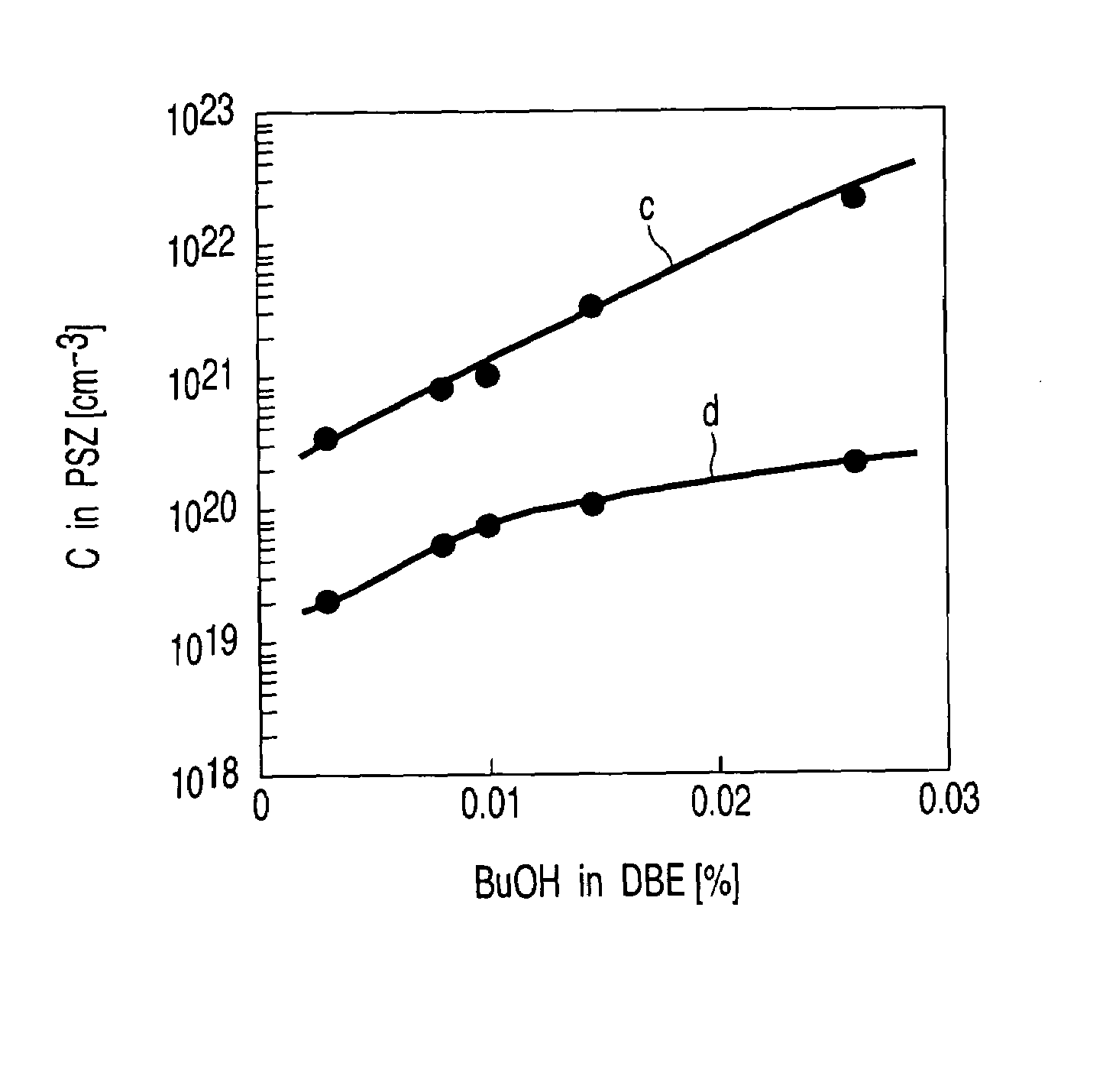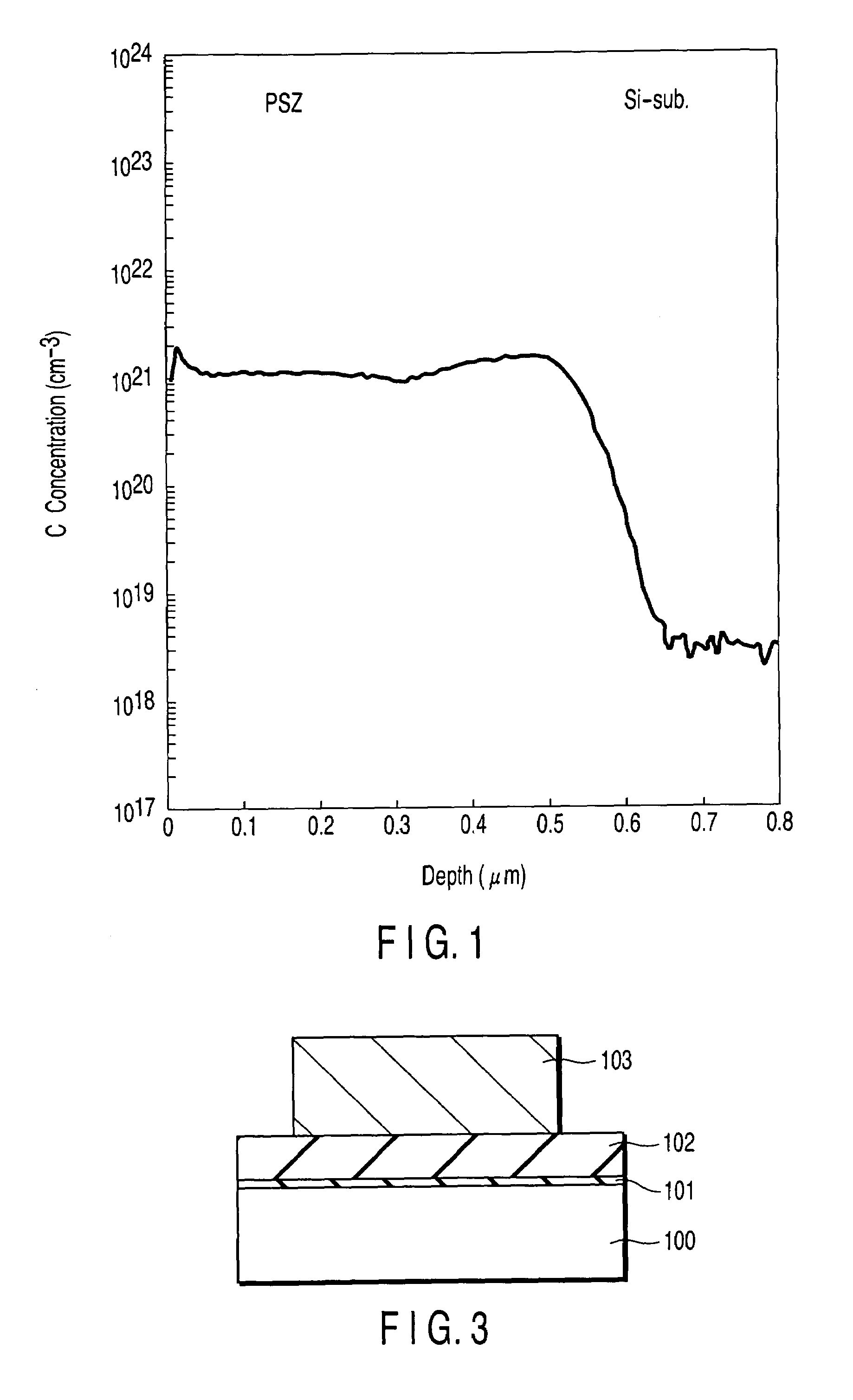Polysilazane perhydride solution and method of manufacturing a semiconductor device using the same
a technology of polysilazane perhydride and semiconductor devices, which is applied in the direction of semiconductor/solid-state device manufacturing, basic electric elements, electric apparatus, etc., can solve the problems of ozone burying, voids or seams, and teos cvd-sio,
- Summary
- Abstract
- Description
- Claims
- Application Information
AI Technical Summary
Benefits of technology
Problems solved by technology
Method used
Image
Examples
embodiment 1
[0049]This embodiment illustrates one example of a burying method for STI, which will be explained with reference to FIGS. 7 to 10.
[0050]First of all, a silicon dioxide film (about 10 nm in thickness) 11 was formed on a silicon substrate 10 by thermal oxidation. Then, by a vacuum CVD method, a silicon nitride film (about 200 nm in thickness) 12 was formed, as a CMP stopper film, on the silicon dioxide film 11. The film thickness of the film to be formed on the substrate may be altered. For example, the film thickness of the CMP stopper film 12 may be varied within the range of about 100-300 nm.
[0051]By photolithography and a dry etching method, an element isolation trench (STI trench) 13 was formed so as to enable the STI trench 13 to pass through the CMP stopper film 12 and the silicon dioxide film 11 and to reach the silicon substrate 10 as shown in FIG. 7. Herein, the configuration of the STI trench 13 was 100 nm in width and 500 nm in depth. However, the width and depth of the S...
embodiment 2
[0059]In the same manner as described in the aforementioned Embodiment 1, a silicon dioxide film 16 was formed on an Si substrate 10 having a silicon dioxide film 11 and a CMP stopper film 12 formed thereon and also having an STI trench 13 formed thereon as shown in FIG. 9. These films were formed using the same materials as described in Embodiment 1, the film thickness of these films also being the same as described in Embodiment 1.
[0060]In this embodiment, the silicon dioxide film 16 was densified prior to the step of CMP. The densification of the silicon dioxide film 16 can be performed through the heat treatment thereof in an inert gas atmosphere at a temperature ranging from 700° C. to 1100° C. If the temperature of this heat treatment is lower than 700° C., it would become difficult to sufficiently densify the silicon dioxide film 16. On the other hand, if the temperature of this heat treatment is higher than 1100° C., the diffusion depth of the channel layer formed in advance...
embodiment 3
[0065]The densification of the silicon dioxide film 16 set forth in the above Embodiment 2 can be performed after the step of burying the silicon dioxide film 16 in the STI trench 13. In this embodiment, in the same manner as described in Embodiment 1, the silicon dioxide film 16 was buried in the STI trench 13 of the Si substrate 10 having a silicon dioxide film 11 and a CMP stopper film 12 formed thereon as shown in FIG. 10. Since the silicon dioxide film 16 was subjected to CMP prior to the densification thereof, the absolute quantity of polysilazane perhydride film was smaller than that of Embodiment 2 and hence the quantity of residual carbon was also smaller as compared with that of Embodiment 2. As a result, it would be advantageous in the respect that the properties of a device would hardly be deteriorated by the densification.
[0066]Then, the heat treatment was performed under the same conditions as in Embodiment 2 to densify the silicon dioxide film 16. As a result, it was ...
PUM
| Property | Measurement | Unit |
|---|---|---|
| temperature | aaaaa | aaaaa |
| temperature | aaaaa | aaaaa |
| width | aaaaa | aaaaa |
Abstract
Description
Claims
Application Information
 Login to View More
Login to View More - R&D
- Intellectual Property
- Life Sciences
- Materials
- Tech Scout
- Unparalleled Data Quality
- Higher Quality Content
- 60% Fewer Hallucinations
Browse by: Latest US Patents, China's latest patents, Technical Efficacy Thesaurus, Application Domain, Technology Topic, Popular Technical Reports.
© 2025 PatSnap. All rights reserved.Legal|Privacy policy|Modern Slavery Act Transparency Statement|Sitemap|About US| Contact US: help@patsnap.com



